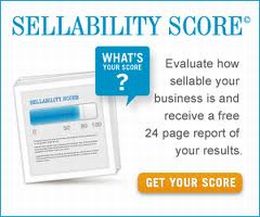Placing a value on your business and determining the best transfer channel for your exit can be a very convoluted process. There are a number of transfer channels and within each transfer channel there are dozens of methods to bring the transaction to fruition. Despite the fact that the transfer of your business can take any one of dozens of paths, the starting point will be the same: your goals and motives for transferring your business.
A sound exit plan should begin with setting your personal and financial goals. Moreover, your goals need to be in alignment. For example, you may want to use the money from the sale of your business to fund your retirement or next planned adventure, so you’ll want to get as much for it as possible to meet your financial goals. However, you may also have a desire to turn the business over to family members – a transfer that typically doesn’t yield the proceeds you may want or need. In this case, your financial goals (best possible proceeds) and your personal goals (leave your business to family) are not aligned, and it may be impossible to bring these two close enough to meet both of your objectives.
You’ll need to do some soul searching in a case like this to determine which matters most and prioritize your goals and objectives in selling your business. Without a prioritization, it is difficult, if not impossible, to determine the transfer channel that will best help you achieve the success you want as you have defined it. Your motives for selling your business will dictate the transfer channel, but you must also align your financial goals with your motives for a cohesive transition.
Value Worlds
Business value in publically held companies is easy to ascertain: You can find it in the stock price. However, when transferring a private company, value determination is not so clear cut. The purpose for appraising a business gives rise to a value world, and there are several value worlds. Values within each value world can be very different, and values are controlled by regulations or situations.
Fair market value is the regulatory standard and reflects a hypothetical opinion of what all buyers in the marketplace say your business is worth. The value of your business to the bank will be very different. The bank isn’t necessarily interested in the goodwill value of your business; instead, they’re focused on your collateral value to secure the loan against your assets in case you default.
On the other hand, if your business represents a particular expansion opportunity to a buyer, it will be more valuable to that buyer than the collateral value or even potentially the fair market value. That represents the business’s investment value. Let’s look at an example.
The owner of XYZ Company wants to know his options. Companies similar to his have a fair market value of $8.3 million. In valuing his company as part of his estate planning strategy of gifting and using a Grantor Retained Annuity Trust, the value is set at $5.8 million, lowering his tax liability. The bank has assessed his assets at $2.7million. If he were to sell all of the equipment and hard assets, that’s what he could expect as the proceeds of the sale. Liquidation value does not consider performance, profitability, or future potential growth. However, XYZ Company has developed a very profitable niche in a particular product development. ABC Company wants to expand its business into this niche, so ABC is willing to pay $10.1 million for the business – investment value.
So what is the value of XYZ Company? It depends on the motives for transferring the business. The situation or regulatory authority will dictate the value for that purpose or how it’s viewed in its value world.
Transfer Channels
There are eight different transfer channels, and there will be different values in each one. A business owner transferring to family may want a low valuation to limit the tax burden, but a business owner selling to a third party with the objective of funding his retirement will want the greatest valuation the market will bear. Transfer channels include:
- Family
- Employees
- Co-owners
- 3rd Party (retire)
- 3rd Party (continue in the business)
- Charitable trusts
- Public
- Liquidation
Each transfer channel has advantages and disadvantages and is driven by the owner’s goals and motives for transferring the business.
Transfer to Family Member(s): Typically this type of transfer is not done for financial reasons, as family members may not have the resources to purchase the business outright. Although this channel does not usually generate extensive, if any, net proceeds, it does leave the company in the hands of those who will likely perpetuate the mission and culture, and it provides the owner with an opportunity to provide employment and income for family members.
Transfer to Key Employee(s): This transfer channel is very similar to that of transferring to a family member. Similar disadvantages exist with added risk: a down payment with seller financing or SBA loan at closing to fund the owner’s retirement or next planned adventure. Similarly, the advantages are also parallel. The company will likely continue with its mission, and management and key employees are more likely to be retained. Owners may opt for this transfer channel when they want to see a continuity of the business they started but do not have family members interested in taking over the company. Employee Stock Option Plan (ESOP) is also an alternative method of transfer.
Sale to Co-owners: As with transfer to family members or employees, a sale to co-owners carries very similar advantages and disadvantages. On the plus side, skill and knowledge to run the business is a known entity, and the company can continue as it has. On the down side, the owner may need to receive proceeds as installments and business valuation will probably be lower.
3rd Party (Retire): This transfer channel typically offers the best chance for the owner to receive maximum value for the business and substantial cash at closing. The drawback in this scenario is that the business owner may not be ready to retire. There may be a desire to continue in the business, and there is no guarantee that the company will continue with its mission or established culture. Additionally, the owner may have concerns, legitimate or not, about employees’ job security post-transition.
3rd Party (Continue in the business): For owners who want to receive greater value for the company but who are not ready to stop working in the business they created, this transfer channel may provide the solution. The advantage is that the owner may receive maximum purchase price while being able to facilitate the growth and continuation of the company without his own investment or risk. However, the owner will also have to accept what may be a difficult challenge: working for and answering to someone else coupled with a loss of owner identity.
Charitable Trusts: The Charitable Remainder Trust (CRT) is a form of irrevocable trust in which the business owner transfers cash or property while retaining the right to receive payments, known as a trust payout, for a specified term or for life. The remaining portion of the trust passes to the charity at that time. Certainly, there is a benefit to the charity, and there is also a benefit to the business owner as the IRS treats the trust income as tax-exempt. However, you lose access to the trust principal and there are some restrictions on the types of investments in which the CRT can invest trust assets.
Public (IPO): Taking a company public may be the dream of every business owner, but it rarely occurs. In the cases in which it does, the valuation of the business tends to be greater than any other form of transfer. Plus, it generates an infusion of cash to move the company forward. However, an IPO is not a liquidity event for the owner. Stock, not cash, is offered at closing, often with restrictions on cashing out for a prescribed period of time. At the same time, the owner is often required to stay in the business and is now suddenly responsible to shareholders with new reporting requirements.
Liquidation: This transfer channel is usually the last resort when the owner must leave, often driven by a health crisis, with no alternatives or exit strategies in place. The only advantages are speed and cash. The disadvantages (as depicted in the valuation example) are that liquidation yields less cash than other transfer channels and is coupled with higher percentages of tax liabilities along with probable devastation to employees, clients, and vendors.
Transfer Methods
Finally, there are various transfer methods within each transfer channel. The transfer method determines the business’s likely value, bringing the process full circle. There are nearly three dozen different transfer methods, and each is associated with a particular transfer channel. Additionally, each method corresponds to a particular value world.
In a charitable trust transfer, value is determined by the fair market value, but selling to a third party in an auction derives value based on market value; that is, who’s willing to pay the most. Ultimately, the owner’s motive drives the transfer channel and subsequent method and finally determines the value.
While the process may seem very complex and convoluted, it all starts with your goals and motives for transferring your business. Once you have a clear understanding of those, the rest of the process will align accordingly.





